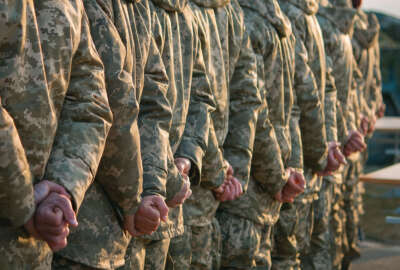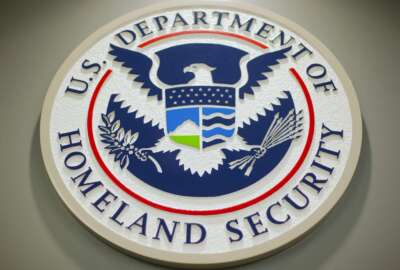Morrison and his team bring sci-fi tech to naval warfare
Peter A. Morrison and the U.S. Navy Solid State Laser Team were recently named Service to America finalists for their work developing the LaWS weapons system for...

Listen to In Depth with Francis Rose’ interview with Peter Morrison.
The work Peter A. Morrison and the U.S. Navy Solid State Laser Team does may sound like something out of a science fiction movie, but it’s a real-life application of a new technology for modern sea warfare.
Morrison and his team from the Office of Naval Research developed LaWS, a laser weapons system that was mounted on the USS Ponce while it was patrolling the Persian Gulf last summer.
“The laser weapons system demonstrates a transformational capability for the Navy, and it will change the way we fight in the future,” said Thomas Beutner of the Office of Naval Research. “Peter Morrison led this program from its inception to its successful completion.”
For his work work building and testing the first-ever laser weapon approved for combat operations on a Navy ship, the Partnership for Public Service recently named Morison and the U.S. Navy Solid State Laser Team as finalists for the 2015 National Security and International Affairs Medal. The award recognizes federal employees who have made important contributions in the area of national security and international affairs. This includes defense, diplomacy, military affairs, foreign assistance and trade.
GETTING TO KNOW PETER MORRISON
Federal News Radio asked each of the Sammies finalists five questions about themselves. Here are Morrison’s responses:
What three words best describe your leadership philosophy?
“Innovation invites Skepticism.”
Change matters, as we look to change things for the “Better” every day. Any form of “Faster, Better, Cheaper” or “Change is good” is often met with a modern measure of skepticism. And “Skepticism” is a healthy and natural response to change, and it should be met with calm, thoughtful explanations with a desire to gain educated advocates. Explaining innovation is a responsibility we should be eager to accept. And expecting change is being ready to ask ourselves, are we ready for the natural skeptical responses? Change sometimes means we need to step back, prepare and think about it, and gain acceptance, rather than just try and force implementing something new.
What’s the best piece of advice (or words of wisdom) you’ve ever received and who gave it to you?
I was sitting in an engineering economics class on a Saturday morning, and the professor, Dr. Gordon, walked in, coffee mug in hand, many years wiser and experienced, looked at the class and stated, “The job of every engineer (in this class) is to put themselves out of a job.” I sat there stunned while he continued, “Because by succeeding or completing their job, they then can start looking for his next thing to improve or change for the better … and that is at the core of what engineering is.”
Who is your greatest role model and why?
I have two.
The first is my father, he was a self-made man from the time he was a teenager, and had to start to support the family after his father died – by working in a steel mill. Then, he went to war in World War Two, and came back to the steel mill, earned a degree, started a family, built a home, and put all four of his kids through college.
Through all that, he still had a desire to achieve something more – a patent, which he never quite was able to do. Before he passed away – I was able to bring a patent through the process and have it awarded. I think the some of proudest moments he had was when his kids were able to accomplish things. It’s the real reason behind the handlebar mustache I wear, as he had one for the magic shows he did. And now I look at it each morning in the mirror as I shave, and remember how much he loved all of us.
My second, is a man who I learned photography from after school in my late teens. His name was Stephen Oroz, and he worked for CBS photographing the Ed Sullivan shows. He taught me about New York City philosophy, and how to see things differently. How light played over three dimensional objects. I soon merged that ability to see things in a new way with the engineering skills my father gave to me, and was able to “see” three dimensional construction techniques long before computer aided design systems came of age. You can tell a lot from a person’s photograph, if you just know where and how to look for it.
What’s the last thing you read and what’s next on your reading list?
Recently, I have been enjoying historical pieces from the era of the American Revolution, having just completed George Washington’s “Rules of Civility,” and just starting Benjamin Franklin’s “Autobiography.” I believe both can be found as free e-Books from Project Gutenberg.
But next will likely be a recreation read on horsemanship, an athletic past- time that allows and requires me to communicate nonverbally to another breathing, thinking being. It is a fantastic sport, teaching patience, trust, principles of progressive aides and interval training, and requires a lot of team focus in order to compete well, and win. There are two sitting on my bookshelf right now, one written by a good friend and instructor, Mike Smith, “Getting the Most from Riding Lessons,” and one by Maj. Anders Lindgren on “Teaching Exercises, A manual for Instructors and Riders.”
Who would you most like to have lunch with and why?
My first response has to be my wife and daughter. They watched me put many late nights in, and stay up late working. Then comes my team, and all those whom I owe numerous gratitudes for helping us along the way to this achievement. And there is a soldier, sailor or airman, unknown to me, returning from a combat zone, perhaps alone for the first time after a long deployment, just to be able to say “Thank you, and welcome home.”
But, let me step out of those, to another personal vignette, since those first ones mentioned will certainly happen over time… But instead offer that I would most enjoy having lunch with a group of motivated kids at a high school science fair.
We’re living in a time that educational opportunities and student capacity is just amazing. Groundbreaking. And that “innovative edginess” is infectious. I occasionally judge science fairs, and encounter those who form a team in order to take it to the next level. Not to win, to innovate. It is palpable. And I get inspired by listening to them. Education, motivation and a desire to try, just to be able to say, “We took it to the next level. We turned the knob past 10, to 11.” Their win isn’t about the blue ribbon, it’s about something new. Perhaps only to them, but perhaps to the world.
Either way, you see it in the dedication, tiredness and the smile when it does come together for the first time and works. The concept of “STEM” (Science, Technology, Engineering and Mathematics) education is enabling these next scientists and engineers to make modern breakthroughs in autonomy, robotics, medicine, physics, engineering and genetics that are benefiting the entire human condition. And high school students today, are making some of “game changing” events occur themselves. It is just awesome to see.
The National Security and International Affairs Medal is just one of the Samuel J. Heyman Service to America Medals (Sammies) presented annually by the Partnership for Public Service. View a photo gallery of all the Sammies nominees.
Copyright © 2025 Federal News Network. All rights reserved. This website is not intended for users located within the European Economic Area.





